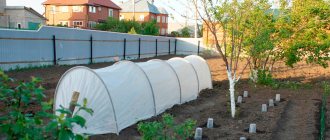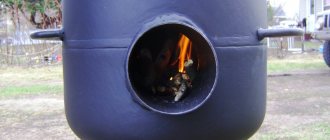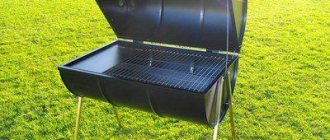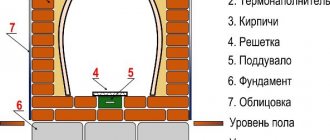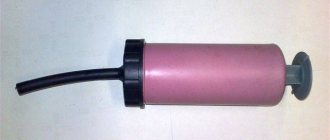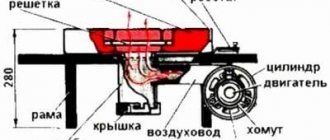Home / Articles
How to organize an autonomous water supply system in a country house so that it works accurately and reliably?
First of all, it is important to follow the rules and regulations. Let's start with SNiP 2.04.01-85 “Rate of water consumption by consumers,” which regulates the average water consumption per person ranging from 80 to 230 liters per day. To ensure the supply of such a quantity, pumping equipment is forced to work intensively, which causes premature wear of parts and regular repairs.
However, there are methods that reduce the number of switches on/off of devices. In this article we will look at the intricacies of proper water supply to a country house.
Description and benefits
The drip irrigation method was first used in Israel in the fifties to combat water shortages. Soon scientists were able to find out that if the supply is made in small portions, then not only water, but also labor resources are saved. Moreover, drip irrigation allows for early harvests.
Conventional watering involves the penetration of moisture into the soil to a depth of 10 cm. And with a gradual drip feed, the root systems are more saturated with moisture, as a result of which they grow faster and, accordingly, receive more nutrients from the ground.
Greenhouse made of cellular polycarbonate
Water barrel
beds
Drip irrigation hose
Pump
A separate dropper is provided for each plant
On a note ! Since the soil remains dry, the risk of waterlogging is minimal. What has a positive effect on plant health is that many serious diseases (such as bacterial spot, blackleg, powdery mildew, etc.) develop precisely with excessive humidity.
Also, supplying water at the root reduces the risk of plant burns due to it getting on the leaves (a similar problem is explained by the lens effect, which is played by small droplets). Irrigation into the root zone reduces the rate of spread of weeds, because they do not receive enough moisture.
Important ! Distinguished by its extreme simplicity, the drip irrigation system helps increase productivity by about 30-40%. This method allows you to calculate both the intensity and time of watering for each specific crop.
Initially, drip irrigation was used only in greenhouses, but later it began to be used for growing in open ground.
A distinctive feature of systems for automatic watering from a barrel is the drip supply of water to the root zone
Reviews
Summer residents note a reduction in the number of days of full watering when using drip irrigation from a barrel.
For 60 cucumber roots, a 100 liter tank is not enough for a week . You have to come in the middle of the week and top up the barrel. It is better to stock up with a capacity of 200 liters.
This volume of water is enough to water a tomato. In general, the gardeners are happy; they no longer need to come and water the greenhouse every day after work. With this type of irrigation, watering is carried out with water heated in the sun.
Gardeners also note low water consumption. I like everything, but they advise raising the tank no less than 2 m, weeds do not grow, the system is quickly washed and repaired.
What about the disadvantages?
The main disadvantage of do-it-yourself drip irrigation is the need for mandatory control. If you incorrectly calculate the amount of moisture, this can lead not only to excessive consumption, but also to the death of plants. The water level in the barrel will have to be constantly checked, topping up if necessary.
Note ! Another significant drawback is the need to periodically clean the holes (due to their small diameter, they often become clogged). Although there is nothing complicated about this, it is enough to simply blow or flush the system.
Drip irrigation has its disadvantages
We also note that the system should be protected from contamination, for which a filter is installed at the inlet, i.e. at the beginning of the hose, which is located in the barrel. An ordinary piece of foam rubber is quite suitable as a filter.
Let's sum it up
Whatever pump you choose, it will definitely make the watering process easier. You can easily and comfortably water your garden. At the same time, you will save your time and nerves.
Varieties of barrel pumps are extremely easy to operate and take up very little space. When choosing a model, it is important to pay attention to the engine power and technical characteristics that will meet your individual requirements.
TOP 3 ready-made kits for drip irrigation
The range of such equipment is quite large, but 3 models that have already been tested by summer residents deserve special attention.
Delta 3L-KP18
A set consisting of 60 droppers is designed for an area of no more than 18 square meters. There is overflow protection, expansion is possible by connecting several systems (a special adapter is used for this). The equipment is rich, you don’t need to buy anything in addition.
Circle Beetle
An inexpensive solution that has everything you need - from IVs and tubes to a timer. The maximum area of the greenhouse is also 18 square meters. Assembly is extremely simple, the hoses do not bloom. Available in 60 and 80 plant versions.
Start LCD AquaDusya
This set with an original and memorable name is highly appreciated by summer residents. The system is universal, suitable for berries, shrubs, fruit trees and flowers. It is equipped with a timer, droppers (70 pcs.), pump and everything necessary for installation. The only negative is the underground laying of the highway.
Delta 3L-KP18
Circle Beetle
Start LCD AquaDusya
1470 rub.
2765 rub.
5980 rub.
Design of polymer storage tanks
Plastic tanks for storing water resources come in various volumes (up to 10,000 liters) and shapes. They can be square, cylindrical, vertical and horizontal, flat, angular.
Tanks are produced in two designs. The first is ordinary containers with smooth walls and a sealed lid equipped with a breathing valve. Any storage tank requires access to air, otherwise it will be flattened by atmospheric pressure when emptied. Conventional tanks are designed for storing water resources, extracting them with an electric pump or using a self-installed tap.
The second option is special tanks for use in individual water supply systems. They have four holes in the body on one side - two at the top and two at the bottom. One top and one bottom hole are equipped with a 1-inch male thread. These bends are used to connect the inlet and outlet pipelines of the water main to them.
There is also a hole with a diameter of 28 mm at the top. It is usually used to organize emergency drainage by connecting a pipeline directed to the street or to the sewer.
It is worth noting that any installer can use the top threaded pipe and hole at his discretion. For example, in a 28 mm cutout you can install a float valve that turns off the water supply when the tank is filled, and a 1-inch threaded pipe can be used for emergency draining.
The 3/4 inch pipe at the bottom is used to empty the tank. The need for this arises when dirt accumulates at the bottom of the container in the form of sand and clay deposits, products of decomposition of metal oxides.
There is a different design for storage tanks for underground installation than the traditional one. Since the soil pressure on the tank walls is quite high, they are equipped with stiffeners. In addition, they have a high neck, which allows them to be immersed underground to a depth below the freezing point.
Rice. 4 Storage tank for water supply - examples of use in the home
How to calculate the volume and duration of watering?
As mentioned above, first a plan is drawn up, which indicates the location of the crops in the greenhouse and the length of the beds. After this, an irrigation diagram is drawn indicating the location of the tank and supply pipelines. All this is necessary to correctly calculate the total length and number of droppers, adapters and other components.
Then the required volume of the barrel is calculated. For example, if the length of the line is 10 m, and the pitch between the nozzles is 30 cm, then 34 of them will be required. With a capacity of each dropper of 5 l/hour, it turns out that all droppers will flow about 170 liters during this time (1 hour).
Important ! With a longer length, the volume of the tank will have to be increased. Or divide the system into two (an alternative is to use a constant source of water instead of a barrel).
Anyone can make a simple version of a drip irrigation system with their own hands.
Organization of water supply at the dacha
It is possible to organize a water supply at the dacha only using a pump, but it can be supplied in two ways: from a storage tank or from a hydraulic accumulator.
When using a scheme with a storage tank, you have a supply of water equal to the volume of the tank, but the pressure in the system is low. It is created by a difference in heights: the tank is installed at a height - in the attic of a summer house or the roof of an outbuilding. The main condition is that its bottom must be located above any water intake point. Then there will be water in the taps.
The second method, with a hydraulic accumulator, is more convenient in that pressure is created and automatically maintained in the system. If the hydraulic accumulator is supplemented with a pump and automation (pressure switch), the entire assembly is called a pumping station. The trick here lies in the hydraulic accumulator. This is a cylindrical container divided into two parts by an elastic membrane. Gas is pumped into one part under low pressure, and water is supplied to the second by a pump. As it enters, the water compresses the gas more and more, which is why pressure is created in the system (about 2 Atm).
Organization of water supply at the dacha from a well with a hydraulic accumulator
When the tap opens (household appliances turn on or watering starts), water is supplied from the accumulator. The pressure in it gradually decreases. Its value is controlled by special relays. As soon as the lower threshold is reached, the pump turns on, restoring its set value. The highest threshold is monitored by a second sensor, which turns off the pump.
A similar country water supply system can be implemented in both winter and summer versions. The difference is where to install the equipment and how deep to bury the pipes.
Master Class. Organization of drip irrigation in a greenhouse
Let's consider the process of arranging the system using the above-mentioned “Beetle” kit, which is produced in the city of Kovrov.
Drip irrigation in a greenhouse from a barrel
Operating instructions for the “Zhuk” drip irrigation kit . Downloadable file (click on the link to open the PDF in a new window).
User manual
Step 1 . First of all, we cut a hose along the length of the beds (in the example - 3 pieces), lay it out over the beds and secure it with clamps. We place a tap/plug at the beginning/end of each segment. We connect the segments, take one to the tank.
The cuttings need to be laid out in beds
Step 2 . Using an awl (it usually comes with the kit), we make holes with the required spacing and install the droppers.
Installation of droppers
Step 3 . As a result of the actions described above, the system in the greenhouse looks like this.
What will the irrigation system look like?
Step 4 . We organize a place for water supply. Since the tank must be raised above ground level (for a pressure of 0.1-0.2 atmospheres the required height is 1-2 m), we build a pedestal from an old refrigerator, and it, in turn, is installed on a special platform, previously made from four paving slabs.
Organization of water supply point
Step 5 . We connect the hose to the barrel. We drill a hole in the latter corresponding to the diameter of the fitting and connect it to the previously laid hose through a fine filter.
Connection of a barrel with a hose
Step 6 . We attach a transparent tube to the tank and hose so that in the future we can determine the water level.
Transparent tube fixed
On a note ! To better see the water level in the barrel, you can place a bright floating ball in a vertical tube.
Tube for determining the water level in a barrel
Step 7 . At the end we paint the refrigerator, and cover the barrel with a lid of a suitable size, otherwise a lot of debris will get inside. That's it, the drip irrigation system is ready, now to start it you just need to open the hose.
Ready-made drip irrigation system from a barrel
Video – Drip irrigation system “Zhuk”
Which pipes to choose for water supply in the country
Just a decade and a half ago, no questions arose: there was no alternative to steel pipes. Today, metal is almost no longer used for country water supply: it is expensive, welding is required for installation, and modern pipes rust quickly. There is a much more practical alternative - plastic pipes. They are the best solution for country water supply: they definitely do not rust, some are also not afraid of frost. But plastic is different, as are the products made from it.
HDPE pipes
Most often, HDPE pipes - low-density polyethylene - are used for water supply in the country. They are attractive because they can be assembled without any additional devices. Fittings for assembling HDPE water pipes are threaded and are simply tightened by hand.
HDPE pipes for water supply systems are produced in coils or in sections (depending on the diameter)
Why are HDPE polyethylene pipes so good that they have almost replaced metal pipes? In addition to convenient installation, there are a number of advantages:
- If the operating rules are followed, the service life is 50 years. This figure has not yet been verified, but it is impressive.
- They do not rot, do not rust, and are resistant to chemical environments.
- Can be operated at temperatures down to -60°C.
- When the water in them freezes, they do not burst - they stretch, then after thawing they return to their previous size.
- Their inner surface is perfectly smooth. For water supply, this is important for two reasons: there is less pressure loss during transportation and deposits do not accumulate on the walls, they are simply carried away by the flow.
- With their help, it is very easy to make water supply in your dacha with your own hands, as well as make changes later.
- HDPE pipes can be used to install summer and winter water supply systems.
- Convenient assembly methods: welding or compression (threaded) fittings.
There are some disadvantages, but they are few:
- do not tolerate heat well (except for cross-linked polyethylene pipes) and are therefore used only for transporting cold media;
- Compared to metal, they have lower strength - you cannot walk on them.
HDPE pipes can be welded with a special apparatus, or they can be connected using compression fittings. For country water supply, pieces of pipe, tees, and adapters are connected using threaded connections. Although such a connection seems unreliable, it can withstand much more than the 2-4 atm that you can create at the maximum. See the video for the results of testing connections on threaded fittings. At the same time, see their design and installation principle.
HDPE pipes with blue lines are suitable for water supply. They are designed for cold water. If the lines are yellow, they cannot be used to supply water - they are intended for gas. They contain special additives that make the water unsuitable.
There are several gradations of working pressure:
- L - light, withstands up to 2.5 atm;
- SL - medium-light - up to 4 atm;
- C - medium - up to 8 atm;
- T - heavy from 10 and above.
For the installation of external (street) water supply in a dacha, class C and SL HDPE pipes with diameters of 32 mm, 40 mm and 50 mm are used. When choosing, you still need to decide on the density.
There are three more brands of polyethylene: PE 63, 80, 100. These numbers indicate density. The denser the material, the stronger the product, but also the higher the price. For example, one linear meter of 32 mm pipe made of PE 80 costs from $4 (and more depending on the wall thickness). The same diameter, but made of PE 100, starting from $7 per linear meter.
Is high density necessary when installing water supply on a chacha? I guess it's yes. Due to the higher density, the pipe walls are made thinner, which reduces their weight. If water at the dacha is obtained from a well or well, weight can be an important factor - there will be fewer problems with securing the pipe lowered down.
PVC pipes
For water supply in the country, they also use pipes made of PVC - polyvinyl chloride. They are cheaper than HDPE and are joined using cold welding - with glue. The seam turns out to be reliable - it can withstand pressure up to 12-16 atm, the service life is stated to be the same: 50 years.
PVC pipes have a low price, but they cannot be scratched
The characteristics are slightly worse than those of low-density polyethylene:
- Temperature range from -15°C to +45°C.
- It does not like freezing - elasticity decreases, the material becomes more brittle.
- Average sensitivity to ultraviolet radiation.
The remaining advantages of plastic pipes are inherent in PVC in full:
- Easy to install, bendable.
- Smoothness of the inner surface.
- Resistance to oxidation (does not rust) and chemical environments.
- Low flammable.
The disadvantages of a dacha plastic PVC water supply are as follows:
- The upper temperature limit is +45°C, briefly possible up to +65°C.
- Difficult to dispose of because when decomposed it releases volatile chlorides that are harmful to health and the environment.
- When scratches appear on the surface of the pipe, its strength is significantly reduced. Therefore, it is not advisable to use PVC pipes for open laying of water supply in a country house. When laying underground, a protective shell or installation in a sewer is required.
Since scratches and cracks greatly reduce reliability, threaded connections are not possible. When connecting to metal pipes or equipment inlets, this is a big problem. And if laying pipes around the site is a simple matter, then piping the equipment is a serious task. This drawback limits the use of this material for external water supply systems, therefore PVC is more often used for internal wiring, where the risk of scratches is minimal. Even more often they are used for laying sewers.
Watch the video to see how to connect PVC pipes. The connection is really reliable. This conclusion is based on personal experience: a cold water comb was collected in the apartment. It stood for about 10 years without any problems, until the entire wiring had to be redone due to redevelopment.
Polypropylene (PPR)
Another material that can be used when installing water pipes in a dacha with your own hands is polypropylene pipes. They also belong to the category of plastics. There are for cold (with blue stripes) and hot water supply, as well as for heating (with red stripes). They are connected using soldering and couplings - there are special soldering irons that are used to heat the plastic on two parts, then connect them. After a couple of minutes the connection becomes monolithic. You don’t even have to buy a soldering iron (it costs about 2-5 thousand rubles) - they rent it in the same stores that sell pipes and fittings for polypropylene water supply.
Polypropylene pipes have essentially one drawback - expensive fittings. For example, a linear meter of a pipe for cold water supply 32 mm in diameter (wall thickness 3 mm) costs about $2, a coupling for connecting two sections of the same diameter costs $1.2. Since the PPR pipe does not bend, everything is assembled using couplings, angles, etc. As a result, the water supply will not be very cheap, but reliable. After all, not only household water pipes are assembled from this material, but also industrial routes.
Polypropylene pipes for country water supply - a good, reliable option
You can read about drip irrigation systems and how to make them yourself in this article.
Master Class. Using a “crying” PVC hose
To simplify the work, if watering is designed for 1-2 beds, you can use the method described below.
Step 1 . First, unpack the purchased hose. In the example, this is a “crying” (oozing) type model made of PVC.
Unpacking the hose
Step 2 . We unwind the hose and lay it along the plants (the photo shows flower beds, but the method is also applicable to beds).
Step 3 . We connect the hose to the fitting, and it, in turn, to the water source.
Connecting the hose to the water supply using a special fitting
Step 4 . We install a plug at the other end of the hose.
Stub
On a note ! All that remains is to open the tap and start the system. Upon completion of the process, the plug is removed, the remaining water is drained from the hose and it is moved to the next bed.
Submersible pump
This type of system works directly in water. There is a centrifugal and vibration unit. The first option is considered more preferable. However, you must buy a filter for it. The unit is installed directly on the water intake hole.
To pump out clean water without small particles, it is better to use a vibration pump. In terms of price, it will be significantly cheaper. Submersible installation can be installed using any method. The main thing is that the water that is pumped helps cool the engine. If the installation is carried out correctly, then even during prolonged operation the engine will not overheat.
Many models have a float switch. It is designed to minimize the risk of breakage. When the liquid level drops below the set level, the pump automatically turns off.
Main advantages:
- there is practically no noise during operation;
- no overheating;
- the unit functions perfectly with partial immersion;
- is compact;
- ease of installation.
Minuses:
- you need good insulation of the electrical cable;
- for repairs, the installation must be removed from the barrel;
- high price compared to surface devices.
Tips for using the system
Here are some useful tips for using a drip irrigation system.
Drip irrigation is a reliable way to save water without compromising the quality of irrigation
- The components used have a small diameter, and therefore the system becomes clogged from time to time. Cleaning will help restore its capacity, which can be done either manually or mechanically. Moreover, special attention is paid to droppers - they need to be disassembled and cleaned of contaminants.
- If rust appears in the water, components and fittings are checked. Instead of metal parts, you can install plastic ones, and the strength of the connections will not be affected. If the filter fails, this is also not a problem - you can replace it with a foam rubber insert (it needs to be cleaned weekly).
- The sealed lid will protect the system from foreign particles and debris.
- After watering, the soil around the plants is loosened or, alternatively, mulched.
Water collection for technical needs
Have you ever thought that rainwater can be collected for technical needs using storage tanks and plastic pipes for water supply already known to you?
To do this, it is enough to install the tank above or below the ground and connect plastic pipes to it for water supply from the drains. An alternative to pipes is drainage trays. However, it is important to ensure that excess water is drained from the container.
Choose a tank material that is safe, durable, lightweight and does not require special care. Plastic tanks have these properties, take a closer look. When choosing polyethylene pipes for water supply, you avoid fakes. Thus, Europlast offers only high-quality and proven products that meet the requirements of GOST 18599-2001.
In the article, we gave general recommendations for organizing water supply at home using a container. For detailed information, as well as selection of the necessary equipment, please contact us. We will help in any situation.
FAQ. Frequently asked questions about drip irrigation
Does drip irrigation affect soil compaction?
Yes, there is a slight decrease in level, a decrease in volume. To provide air access to the root system, you can use a pitchfork to puncture the soil. And in the fall, dig up the area.
Should the tape be buried for watering seedlings? What pitch between holes is required?
It does not matter where exactly the water source will be located. As for the step, it depends on the length of the row and the structure of the soil. If the soil is sandy, then the required step is 10-20 cm, if it is medium-grained, then 30 cm. If the planting row is long, a distance of about 40 cm is maintained.
Why does a tape with emitters water poorly?
In this case, you need to check how high the water tank is above the ground. Its optimal height is about 1.8 m.
How to store drip tape?
During operation, we recommend avoiding excessive pressure and mechanical damage. In winter, you need to wind the hose onto a reel, but so that it does not bend or break. Store in a room with temperatures above zero.
Phytosporin in the greenhouse: we treat beds, walls, plants
Criteria for building the best greenhouse: what to look for?
DIY greenhouse: review of popular designs
Rules for organizing watering of various crops in a greenhouse
Where to begin?
The arrangement of water supply in an automatic or semi-automatic mode begins with planning and project development and ends with periodic maintenance. At the first stage, it is important to analyze:
- What is the source of water supply (well, well)?
- What plumbing fixtures are planned to be installed in the house (number of toilets, sinks, bathtubs, showers, swimming pools)?
- What problems should the water supply system solve (dependence on electricity, minimum water supply, ensuring stable pressure on all floors, etc.)?
- Where is the equipment planned to be installed (in the technical room or outside the house)?
To ensure uninterrupted operation, it is important to use storage tanks that are needed to store water. A reserve supply is important in emergency situations, such as when the power goes out temporarily. This is the second advantage of installing storage tanks.
There is a well. What's next?
Now that we have become the owners of our own well with completely free, and, moreover, drinking water, a natural question arises - how to deliver this water to the surface. You can't put a bucket in a well. This means that other solutions are needed.
The simplest and cheapest thing is to install a manual water pump .
By moving the handle up and down, we can easily fill the bucket with clean water from the well. If you don’t set super-tasks, then such a column will be more than enough for cooking, light watering, washing dishes and an evening shower. At the same time, you can slightly normalize your pampered torso.
But if there is also electricity at the dacha, then you can think about a more convenient way to extract water from the depths. For example, you can use a simple submersible pump .
They come in different shapes and power. Some descend directly into the well and are constantly in the water at great depths. Others are located on the surface, and only the water intake pipe is lowered into the well.
In principle, no one bothers you to lower the submersible pump into the existing well on the site. If you are not going to use this system in winter, then the task is greatly simplified. If you live in the house all year round, you will have to spend some effort to bury the pipe that goes into the house from the pump into the ground. Otherwise, in winter, the water in the pipe will simply freeze and your water supply from the well will immediately fail.
It's not that difficult. It is enough to dig a trench from the well to the house to the depth of soil freezing:
Next, we dig under the foundation and lay the pipe so that even in the most severe frost the water in it does not freeze. Of course, at first glance, this is a lot of hard work, but it is better to do it once, but then enjoy comfort for many years.
Let's return to the pumps. The very first parameter by which you should choose a device is its power. You must know the depth of your well (you can look it up in the passport, which, I hope, was given to you after the work was completed) and buy a device with a margin of 25-30%. If there is not enough power, the pump simply will not be able to lift water through the pipe to the surface.
A pipe and an electrical cable are connected to the pump and the entire system disappears into the cold depths to spend its “best years of life” there. Most likely, you will see your pump again only in the fall, when you leave the dacha. For the winter, it is better to pull it out of the well and put it away. Not because something will happen to him. They might just steal it. Our people are kind.
In the case of a private house for year-round use, the pump will be removed from the well only when it fails.
If you limit yourself to one pump, then you get this design:
If you turn on the electricity and open the tap, water will flow from the well. You can substitute a bucket or trough, you can attach a hose and fill the pool, or you can... But what if you run this hose into the house? That would be just great! I turned on the switch and water flowed from the tap. Anything is better than washing under a sink and washing dishes in a basin :).
And, in principle, there are no special problems! We installed a sink, ran a hose into the house, turned on the pump at the right time, and water began to flow. If you want, wash your face, if you want, wash the dishes, if you want, pour it into a bucket to wash the floor.
However, this is only one side of the issue - looking through rose-colored glasses. Several side problems immediately arise. For example, where should waste water be disposed of? You won’t just dump it underground :). You can, of course, put a bucket under the sink, but this is again a half-measure.
On the other hand, water that has just been extracted from the depths of the earth usually has, frankly speaking, a very moderate temperature. Four or five degrees. I would see how some people, accustomed to all the comforts, would wash their faces with it. And, I must admit, washing dishes is not a fountain. Especially the fat one.
Finally, constantly turning the pump on and off “for nothing” undermines its resource. It’s already bad for him in the depths, but here we constantly turn it on for a few seconds.
Well, and finally: the water pressure at the pump is quite strong. Can you imagine what will happen if you direct this stream into the sink through a regular faucet? I think the very first activation will push you to the idea that it’s worth looking for a “more different” solution :). How do you say? Are you opening the mixer not all the way? Yeah! What if the pipe breaks off the faucet?
So smoothly and gradually we approached water pumping stations - the latest invention of mankind, which solves most of the problems of water supply to country houses. Either from wells, or from boreholes, or even from a river flowing past.
